The Samsung 960 EVO (1TB) Review
by Billy Tallis on November 15, 2016 10:00 AM ESTMixed Random Read/Write Performance
The mixed random I/O benchmark starts with a pure read test and gradually increases the proportion of writes, finishing with pure writes. The queue depth is 3 for the entire test and each subtest lasts for 3 minutes, for a total test duration of 18 minutes. As with the pure random write test, this test is restricted to a 16GB span of the drive, which is empty save for the 16GB test file.
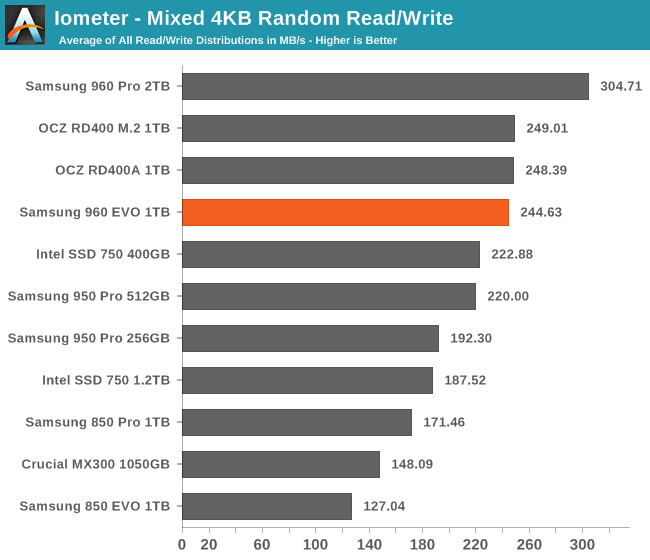
The 960 EVO is essentially tied for second place with the OCZ RD400 and significantly behind the 960 Pro in overall performance on mixed random I/O.
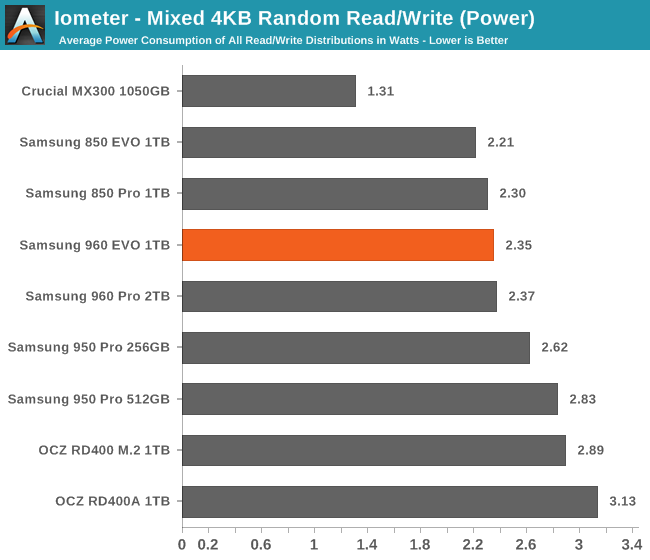
The 960 EVO's power efficiency on this test is not great, but it is a big improvement over last year's 950 Pro.
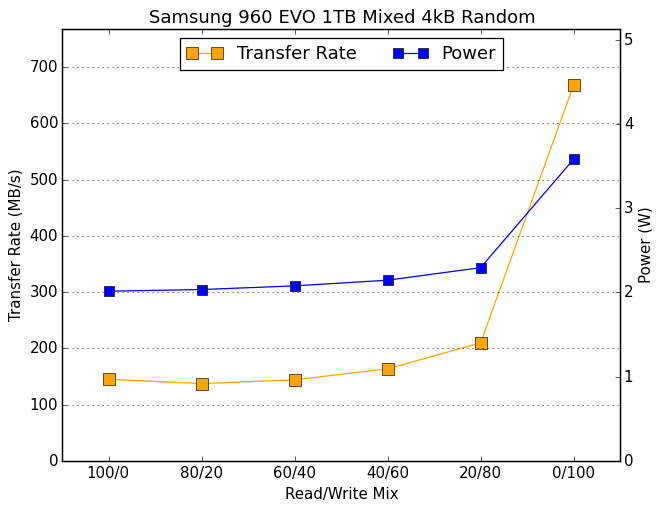 |
|||||||||
The 960 EVO's high performance score comes primarily from its great performance in the pure write final phase of the test. Throughout the rest of the test, the 960 EVO is not as fast as the 950 Pro.
Mixed Sequential Read/Write Performance
The mixed sequential access test covers the entire span of the drive and uses a queue depth of one. It starts with a pure read test and gradually increases the proportion of writes, finishing with pure writes. Each subtest lasts for 3 minutes, for a total test duration of 18 minutes. The drive is filled before the test starts.
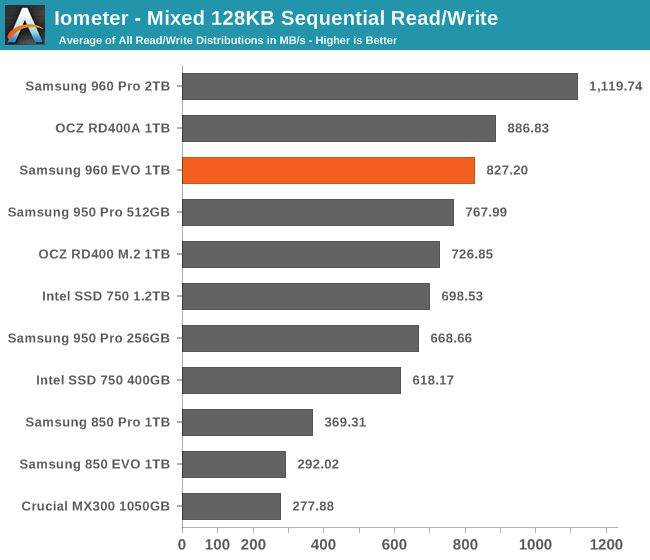
The 960 EVO's mixed sequential I/O performance is the second-fastest among M.2 SSDs and third place overall. Performance is modestly improved over the 950 Pro.
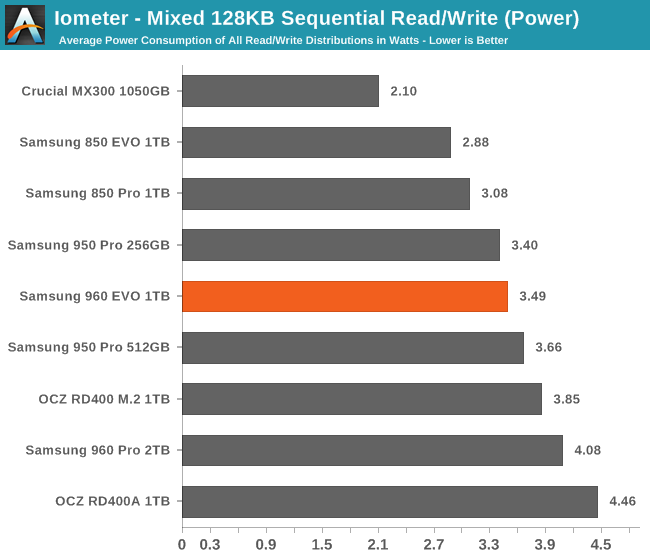
The 960 EVO's power efficiency is better than most PCIe SSDs, but still well behind the 960 Pro.
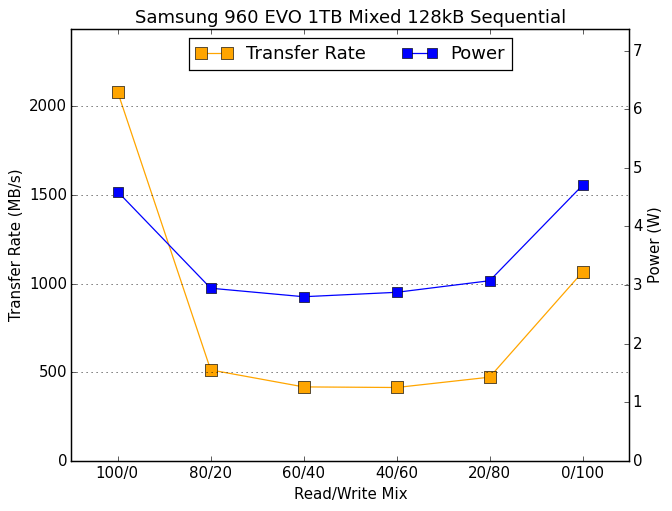 |
|||||||||
The 960 EVO's performance in the pure read first phase of the test is great, but its performance with an 80/20 mix is much worse than the 950 Pro or OCZ RD400. The worst-case performance is also not as good as the RD400 or 960 Pro.










87 Comments
View All Comments
Lolimaster - Wednesday, November 16, 2016 - link
The pci.e speed only matters if you move with huge chunks of data such as a high res video editing. For pretty much anything else it offers nothing over sata ssd's.Flying Aardvark - Wednesday, November 16, 2016 - link
"The pci.e speed only matters if you move with huge chunks of data such as a high res video editing. For pretty much anything else it offers nothing over sata ssd's."In which case, you'd want something that won't throttle under heavy load like the Intel 750. Otherwise, the 600P makes more sense in M.2 form (if it remains cheaper than the 960 EVO).
MajGenRelativity - Tuesday, November 15, 2016 - link
While I agree that both SSD's are fantastic performers (I bought a 500GB 850 Evo), I don't think that your statement on buying other products is right. Some users cannot afford either, and a cheaper SSD would provide a nice uplift.Samus - Wednesday, November 16, 2016 - link
The 860 EVO is selling around 20% more than the 850 EVO did at launch. Just because its NVMe doesn't mean Samsung can milk that much more out of it, the Intel 600p is NVMe and it cost almost half the price. And...Intel. I get that Samsung has improved tremendously in SSD reliability but many of us still have a sour butthole from the 840 TLC drives they never really fixed and honestly, we're comparing Porsches to Ferraris here. Nobody is going to notice the difference between these drives is day-to-day tasks.close - Wednesday, November 16, 2016 - link
"And...Intel"Can't say I really agree with this "default" view since I happened to see the end-of-life behavior for some Intel SSD's. This was some years ago (4-5) so the experience might not be relevant now but for multiple SSDs when they got close to their end of life I just got a warning popup in Windows to back up my data. That's it. I foolishly made the assumption that I can just image the SSD to speed up the process only to realize after the reboot that the SSD controller just killed itself on shutdown.
This isn't the kind of behavior you expect from any data storage medium. The explanation was that Intel was trying to avoid data loss from the drive just failing due to wear. And they chose to mitigate this by triggering data loss by design choice.
While the price and performance may be good I still have to think twice (or more) when considering Intel SSDs.
Phattio - Wednesday, November 16, 2016 - link
@close: thank you for posting this. good to know!Samus - Thursday, November 17, 2016 - link
Wow interesting I've come across dozens of X25-M's and lowest health I've seen was 77% in Intel SSD Toolbox and that was a 300GB SSD320 in an exchange server. The MDB was over 100GBAscaris - Friday, December 16, 2016 - link
Have to agree; that's completely unacceptable behavior. Samsung's 840 Pro (I think it was) went way, way beyond its rated life in the TechReport test (over 1 petabyte) before finally giving up the ghost. If the Intel in question bricked itself based on published ratings, it could have cut its useful life in half. I don't know if that's how it did it... a better way (that it could feasibly have also used) would be to issue the warning when most or all of the overprovisioned spare cells have been deployed to replace those that have worn out (which ought to be a sure sign that all of the cells are close to the edge because of wear leveling)... but if anything, it should go read-only, not brick itself.DrunkenDonkey - Tuesday, November 15, 2016 - link
Billy Tallis, can you make a QD1 comparison graph alongside the mix of 1,2,4? Because average end user pretty much only cares for 4k QD1, RR, the mixed stat is more niche and not indicative. Thanks.Flying Aardvark - Wednesday, November 16, 2016 - link
Seconded. Reads like an ad otherwise.